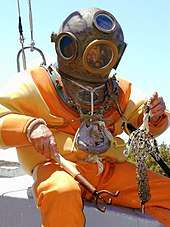Decompression illness
Decompression Illness (DCI) describes a range of symptoms arising from decompression of the body.
DCI can be caused by two different mechanisms, which result in overlapping sets of symptoms. The two mechanisms are:
- Decompression sickness (DCS), which results from metabolically inert gas dissolved in body tissue under pressure precipitating out of solution and forming bubbles during decompression. It typically afflicts underwater divers on poorly managed ascent from depth or aviators flying in inadequately pressurised aircraft.
- Arterial gas embolism (AGE), which is gas bubbles in the bloodstream. In the context of DCI these may form either as a result of bubble nucleation and growth by dissolved gas into the blood on depressurisation, which is a subset of DCS above, or by gas entering the blood mechanically as a result of pulmonary barotrauma. Pulmonary barotrauma is a rupturing of lung tissue by expansion of breathing gas held in the lungs during depressurisation. This may typically be caused by an underwater diver ascending while holding the breath after breathing at ambient pressure, ambient pressure escape from a submerged submarine without adequate exhalation during the ascent, or the explosive decompression of an aircraft cabin or other pressurised environment.
In any situation that could cause decompression sickness, there is also potentially a risk of arterial gas embolism, and as many of the symptoms are common to both conditions, it may be difficult to distinguish between the two in the field, and first aid treatment is the same for both mechanisms.
Mechanisms of injury
- Refer to the main article decompression sickness for the mechanism of injury behind DCS.
- Refer to the main article arterial gas embolism for the mechanism of injury behind AGE.
Signs and symptoms
Below is a summary comparison of the signs and symptoms of DCI arising from its two components: Decompression Sickness and Arterial Gas Embolism. Many signs and symptoms are common to both maladies, and it may be difficult to diagnose the actual problem. The dive history can be useful to distinguish which is more probable, but it is possible for both components to manifest at the same time following some dive profiles.
| Decompression sickness | Arterial Gas Embolism |
|---|---|
| Signs | |
|
|
| Symptoms | |
|
|
First aid
First aid is common for both DCS and AGE:
- Monitor the patient for responsiveness, airway, breathing and circulation, resuscitate if necessary.
- Treat for shock.
- Lay the patient on their back, or for drowsy, unconscious, or nauseated victims, on their side.
- Administer 100% oxygen as soon as possible.
- Seek immediate medical assistance, locate a hospital with hyperbaric facilities and plan for possible transport.
- Allow the patient to drink water or isotonic fluids only if responsive, stable, and not suffering from nausea or stomach pain. Administration of intravenous saline solution is preferable.
- Record details of recent dives and responses to first aid treatment and provide to the treating medical specialist. The diving details should include depth and time profiles, breathing gases used and surface intervals.
Treatment
Treatment for the Decompression Sickness and the Arterial Gas Embolism components of DCI may differ significantly. Refer to the separate treatments under those articles.
References
- Diving First Aid Manual, John Lippmann and Stan Bugg, DAN SEAP Membership Edition
- The Diving Emergency Handbook, John Lippmann and Stan Bugg, ISBN 0-946020-18-3
